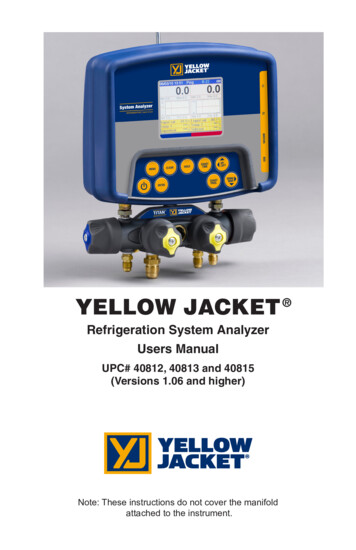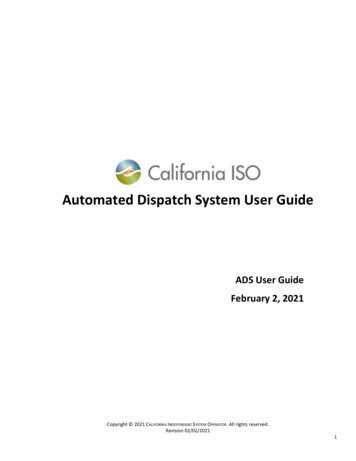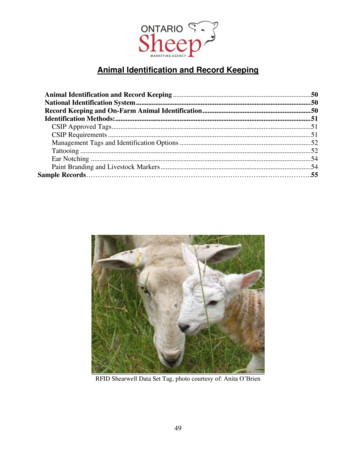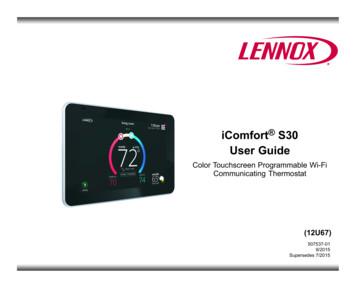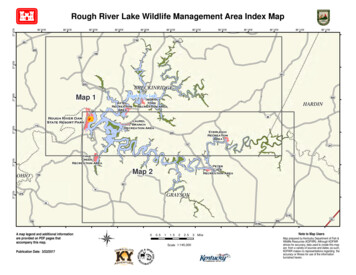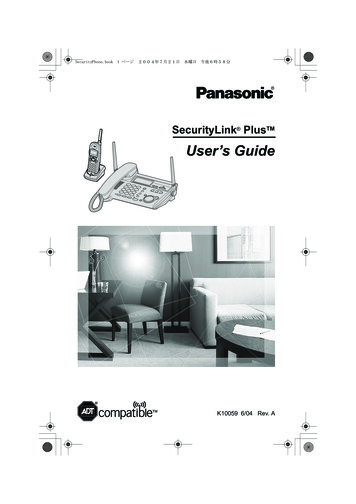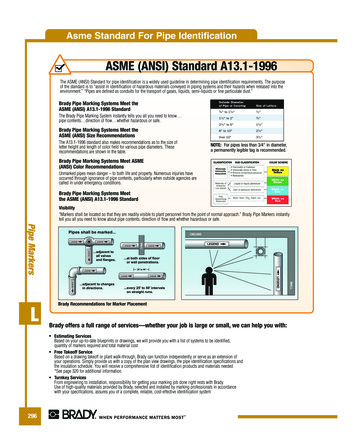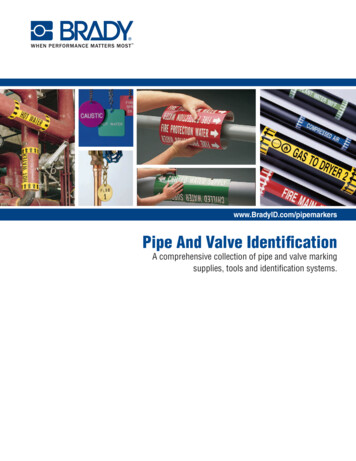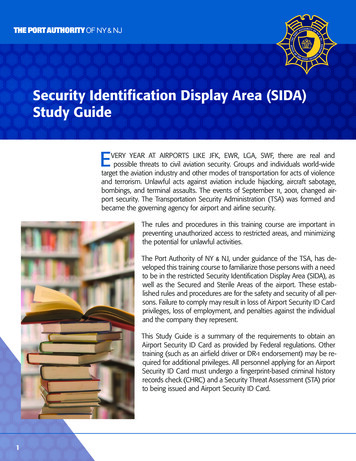
Transcription
Security Identification Display Area (SIDA) Study GuideSecurity Identification Display Area (SIDA)Study GuideEVERY YEAR AT AIRPORTS LIKE JFK, EWR, LGA, SWF, there are real andpossible threats to civil aviation security. Groups and individuals world-widetarget the aviation industry and other modes of transportation for acts of violenceand terrorism. Unlawful acts against aviation include hijacking, aircraft sabotage,bombings, and terminal assaults. The events of September 11, 2001, changed airport security. The Transportation Security Administration (TSA) was formed andbecame the governing agency for airport and airline security.The rules and procedures in this training course are important inpreventing unauthorized access to restricted areas, and minimizingthe potential for unlawful activities.The Port Authority of NY & NJ, under guidance of the TSA, has developed this training course to familiarize those persons with a needto be in the restricted Security Identification Display Area (SIDA), aswell as the Secured and Sterile Areas of the airport. These established rules and procedures are for the safety and security of all persons. Failure to comply may result in loss of Airport Security ID Cardprivileges, loss of employment, and penalties against the individualand the company they represent.This Study Guide is a summary of the requirements to obtain anAirport Security ID Card as provided by Federal regulations. Othertraining (such as an airfield driver or DR-1 endorsement) may be required for additional privileges. All personnel applying for an AirportSecurity ID Card must undergo a fingerprint-based criminal historyrecords check (CHRC) and a Security Threat Assessment (STA) priorto being issued and Airport Security ID Card.1
Security Identification Display Area (SIDA) Study GuideI.DEFINITIONSAircraft – for the purposes of this study guide, aircraft is defined as a fixed wingaircraft (examples are 747, 777, A320, A380, jet or propeller aircraft) or helicopter.Most of theseterms are airportspecific terms:Air Operations Area (AOA) – This area includes aircraft movement areas, aircraftparking areas, aircraft loading ramps, and aircraft safety areas, and any adjacentareas (such as general aviation areas).Airport Police – Port Authority Police Department (PAPD) officers working at theAirport.Airport Security Manager – the Airport’s primary contact for security-relatedactivities, communications, training and compliance with TSA regulations.2
Security Identification Display Area (SIDA) Study GuideAirport Security Program (ASP) – an airport operator’s security programrequired and approved by the TSA. Airports must follow approved programs andensure those security measures outlined in the program are complied with by alltenants and users of the Airport.Airfield – A part of the AOA, that support aircraft operations, such as runwaysand taxiways.Challenge – a demand to produce and display an Airport Security ID Card inaccordance with TSA regulations. Personnel with an Airport Security ID Cardare required to challenge anyone (see “challenge procedure”) not appropriatelydisplaying an Airport Security ID Card in the restricted areas of the airport.Challenge Procedure – the process by which individual(s) with unescorted accessto the restricted areas of the airport are required to identify and communicatewith, approach, and/or point out to appropriate authorities, individual(s) or vehiclespresent in restricted areas but not displaying airport approved identification.Escort – when an individual that has airport approval to escort individual(s) oraccompany or monitor the activities of individual(s) who do not have unescortedaccess to the restricted area.EWR – Newark Liberty International AirportFAA – Federal Aviation Administration that regulates the Aviation Industry3
Security Identification Display Area (SIDA) Study GuideGeneral Aviation (GA) – General aviation (GA) is the term for all civil aviationoperations other than scheduled air services and non-scheduled air transportoperations. General aviation flights range from gliders and powered parachutes tocorporate business jet flights.JFK – John F. Kennedy International AirportLGA – LaGuardia AirportBE ALERTBEBEALERTAWAREBE AWARESPEAKUPSPEAKUPReport airport crime, suspicious activity or breaches of airport securityat JFK and be eligible for cash awards from 50 - 1000CALL THE PORT AUTHORITY POLICE (718) 244-4333Piggybacking – When an unauthorized person enters a restricted area using theaccess privileges of a person who is authorized to gain entry. This is an illegal andunauthorized act.Public Area – Areas normally accessible to the general public, including the publicportions of all terminal buildings, parking lots and roadways.Secured Area – Goes beyond the SIDA area (see SIDA definition below) byrequiring access controls and is the highest level of security. A SIDA ID is stillrequired to be displayed in the secured area.AIRPORT COMMUNITY WATCH PROGRAMAirport Community Watch Program is jointly sponsored by the Aviation Development Council and the Police Crime Prevention Unit of thePort Authority of New York & New Jersey. Airport Community Watch Program is administered and managed by the Aviation Development Council,whose members include the scheduled airlines serving LaGuardia, John F. Kennedy and Newark Liberty International Airports.Security Identification Display Area (SIDA) – A portion of the airport, inwhich security measures specified in Title 49 of the Code of Federal Regulationsare carried out. This area includes the secured area.Security Responsibilities – As an Airport Security ID Card holder you must nottamper or interfere with, compromise, modify or circumvent any security systemor security procedures at this airport. No one may divulge security information orrecords that are labeled as sensitive security information unless approved by theTransportation Security Administration.4
Security Identification Display Area (SIDA) Study GuideSterile Area – An area of the airport which provides access for boarding ontoand off of aircraft (also referred to as the Gate Area). Access to this area is highlyrestricted, and only ticketed passengers and individuals with an Airport Security IDCard may enter this area via the TSA Passenger Screening Checkpoint.SWF – Stewart International AirportTEB – Teterboro AirportTransportation Security Administration (TSA) – a Federal agency providingfederal security oversight, passenger and baggage screening, employee screeningand guidance for the airport’s security program.5
Security Identification Display Area (SIDA) Study GuideIII.GENERALSECURITY ANDSAFETY RULESNo Smoking in the terminals or on the Main Ramps and Airfield. Theproximity of aircraft, fuel trucks, equipment, and terminal heating fuel storagemake it extremely dangerous to smoke or leave cigarette butts smoldering.Report Suspicious Persons or Activity. It is important to report unusual orsuspicious persons or activities immediately to the Port Authority Police Department(PAPD) for investigation. It is for the safety and security of everyone at the Airport.If you see something, say something. Be Alert. Be Aware. Speak Up.IV.GENERAL IDCARD RULESSecurity is Everyone’s Business! – Everyone issued an Airport Security ID Cardis expected to assist with Airport Security measures. It is a card holder’s duty toabide by the rules and regulations and to report security incidents to PAPD. Failureto comply with federal airport security rules and regulations, and failure to reportsecurity violations may result in civil penalties.ID Cards are a Privilege! – There are rules, regulations and responsibilities thatcome along with the issuance of an Airport Security ID Card. If not followed, thecard will be suspended or revoked. Each type of Airport Security ID Card representsa specific level of security. The employer and the Airport Operator will determinethe type of card necessary for each individual.Never Lend Out an ID Card – Not even to a co-worker. An Airport Security IDCard is only to be used by the individual to whom it has been issued.Airport Security ID Cards Must Be Worn on the Outermost Clothing, Abovethe Waist and Below the Neck.Airport Security ID Cards MUST be worn at all times while in a Sterile orSecured Area. When putting on or removing a jacket, remember to move yourAirport Security ID Card to the outermost layer of your clothing. Airport Security IDCards must be visible. They may be worn in a clear display pocket, on a lanyard orclipped to the individual’s clothing.Report Lost or Stolen Airport Security ID Cards Immediately. It is the duty ofeach card holder to keep track of their Airport Security ID Card. It is also the dutyof each card holder to report a lost or stolen Airport Security ID Card immediatelyto Airport Operations or the Airport Security ID Office so that access can bedeactivated. If the Airport Security ID Card was stolen, it must also be reportedto PAPD. The card holder will be held responsible for any illegal access which hasbeen gained through the use of a lost or stolen card holder.6
Security Identification Display Area (SIDA) Study GuideAll Card Holders Must Swipe Their Airport Security ID Card Prior to Enteringa Secured Area. Do not allow anyone to enter the secured area under your swipeor access. Each authorized person must swipe their own Airport Security ID Cardwhen they enter restricted areas. Piggybacking others is not allowed. A card holdermay not escort another card holder.Ensure No Unauthorized Entry. When you enter or exit a restricted area, ensurethat no one gains unauthorized entry into these areas while a door or gate is open.The card holder must make sure the door or gate closes behind them and that noone has gained entry into the restricted area, unless under escort of an authorizedcard holder.Airport Security ID Cards Are the Property of the Port Authority. They maybe confiscated, de-activated or revoked at any time the Airport believes that useby a person may endanger the security or safety of the Airport. Airport SecurityID Cards must be returned to the Issuing Officer once an individual is no longeremployed at the airport or no longer requires an Airport Security ID Card.Challenge. A card holder is required to challenge person(s) in a restricted area toensure the individual is authorized to be present in that area. A challenge is a requestto see a valid Airport Security ID Card or other approved credential that allows thatperson to be in a restricted area of the airport. If a person does not have a validAirport Security ID Card, or the ID Card is expired, notify PAPD immediately.Report Security Concerns Immediately. As a part of the security team at thisairport, a card holder has the continuing duty to report security breaches, suspiciousactivity, or suspicious individuals on the airport to the Airport Police (PAPD). Toreport such activities, call PAPD (see important numbers on last page for the PAPDnumber for each airport.).Airport Security ID Card Suspension/Revocation. The Airport reserves the rightto refuse, suspend, or revoke an ID Card to any individual when it has beendetermined to be in the best interest of the Airport and airport security. The TSAmay supersede the Airport’s decision to grant or deny an Airport Security ID Cardto a person.Civil Penalties and Enforcement. Failure to comply with any federal airport securityrules and regulations may result in civil penalties or other enforcement actions.7
Security Identification Display Area (SIDA) Study GuideV.AIRPORTSECUREDAREASThe Airport has several different levels of secured areas: Sterile, AOA and Secured.These areas are delineated by perimeter fencing, gates, terminal buildings withaccess doors or painted boundaries on the ramps or within buildings. Accessdoors entering into these areas are marked with warning signs.SECURITYESCORTREQUIRED PASTTHIS POINTVI.AIRPORTAPPROVEDIDENTIFICATIONMEDIAIn order to access any of these areas of the airport,a person must have authorized access or be underescort of an individual who has authorized accessand escort privileges. Approved identification mediamust always be displayed for unescorted access inrestricted areas.There are a variety of Identification “ID” cards in secured (Sterile, AOA, Secured)areas of the Airport. Most of the ID Cards are issued by the Airport, but some maybe Airline crew ID cards or Federal Agent ID cards. It is important to recognizethese ID Cards or to call a supervisor or PAPD when in doubt.Your Airport Security ID Card. Airport Security ID Cards are required to enter intoa restricted or secured area. The Airport has a variety of different Airport SecurityID Cards that allow access to restricted areas of the Airport. ID Cards have specificcolors for specific areas of the Airport. The color coding is for easy identificationfrom a distance. The color of the card will tell whether a person has “Secured”(RED), “Sterile Area” (BLUE), or “Snow” (GREEN at JFK and LGA only) access. IDCards must be renewed annually prior to their expiration date.Airline Crew ID Cards. The airport allows some airline crew members to weartheir airline ID in the Sterile area and around the vicinity of their aircraft and theirflight operations center. The crew member must display their ID and be in anapproved airline uniform.Federal ID Cards. A variety of Federal Agents are allowed in the restricted areasfor various reasons. The Federal Aviation Administration (FAA), Department ofHomeland Security (DHS) which includes Transportation Security Administration(TSA), Customs and Border Patrol (CBP), and Immigration and Naturalization (ICE)are just a few of the Federal agencies with inspectors and employees that have todisplay Federal ID cards and require access to restricted areas of the Airport.8
Security Identification Display Area (SIDA) Study GuideVII. CHALLENGEPROCEDURESAirport Security ID Card holders must recognize the various Airport Security IDtypes for each area of the Airport. All individuals that have been issued AirportSecurity ID Cards are required to challenge anyone not showing a proper card ina restricted area. A challenge is a demand to show the proper, unexpired AirportSecurity ID Card or other approved credentials. Failure to display the proper ID cardin a restricted area will result in immediate removal from that area. Anytime youare unfamiliar or unsure if an ID card is valid, report it to PAPD immediately.VIII. ESCORTPRIVILEGE“Escort” means that a person without an Airport Security ID Card may enter arestricted or secured area ONLY if accompanied by a person with a valid AirportSecurity ID Card with escort privileges. The person under escort must be withinsight and hearing of the authorized card holder who is responsible for providingthe escort. Non-badged persons must remain under escort the entire time theyare in a restricted area. Escort Privileges are noted on the Airport Security ID Cardas “EP” or “EV”.AN INDIVIDUAL THAT DOES NOT HAVE AN “EP” or “EV” ON THEIR AIRPORTSECURITY ID CARD MAY NOT PROVIDE ESCORT.Individuals who have a valid Airport Security ID Card and may have lost or forgottenit for that day, MAY NOT BE ESCORTED.Individuals who have been denied an Airport Security ID Card MAY NOT BEESCORTED.IX.VIOLATIONOF RULESPENALTIES AND SUSPENSION OF AIRPORT SECURITY ID CARD PRIVILEGESFailure to follow any of the rules, regulations or procedures may result in fees orfines to an individual or a company in violation. Federal enforcement action orprosecution may also accompany fines (up to 12,800 per infraction).Other security violations may require that an individual’s Airport Security ID Cardbe suspended or revoked.The Airport may revoke an individual’s ID Card privileges at any time (regardlessof any previous offenses) if the violation is severe, or if the Airport, or the TSA,believes that the person may be a threat to the Airport’s safety and security.9
Security Identification Display Area (SIDA) Study GuideIMPORTANT CONTACTSEWRPort AuthorityCustomerCareJFKCare EWR EMERGENCY (Police/Ambulance/Fire) . . . . 973-961-6666 JFK EMERGENCY (Police/Ambulance/Fire) . . . . . 718-244-4333 EWR POLICE (Non-Emergency). . . . . . . . . . . . . . . 973-961-6230 JFK POLICE (Non-Emergency). . . . . . . . . . . . . . . . 718-244-4335 EWR OPERATIONS. . . . . . . . . . . . . . . . . . . . . . . . . 973-961-6054 JFK OPERATIONS. . . . . . . . . . . . . . . . . . . . . . . . . . 718-244-4111 PA POLICE TIPS LINE. . . . . . . . . . . . . . 1-800-828-PAPD(7273) PA POLICE TIPS LINE. . . . . . . . . . . . . . 1-800-828-PAPD(7273)LGAPort AuthorityCustomerCareSWFPort AuthorityCustomerCare LGA EMERGENCY (Police/Ambulance/Fire) . . . . . 718-533-3911 SWF EMERGENCY (Police/Ambulance/Fire) . . . . . . . . . . . . . . 911 LGA POLICE (Non-Emergency). . . . . . . . . . . . . . . . 718-533-3900 NYS POLICE (Non-Emergency) . . . . . . . . . . . . . . . 845-567-9257 LGA OPERATIONS. . . . . . . . . . . . . . . . . . . . . . . . . . 718-533-3700 SWF OPERATIONS . . . . . . . . . . . . . . . . . . . . . . . . . 845-838-8237 PA POLICE TIPS LINE. . . . . . . . . . . . . . 1-800-828-PAPD(7273) AIRPORT ID OFFICE. . . . . . . . . . . . . . . . . . . . . . . . 845-838-8238TEB TEB EMERGENCY (Police/Ambulance/Fire) . . . . . . . . . . . . . . . 911 TEB POLICE (Non-Emergency). . . . . . . . . . . . . . . . 973-961-6230 TEB OPERATIONS. . . . . . . . . . . . . . . . . . . . . . . . . . 201-393-4081 TEB OPERATIONS CELL. . . . . . . . . . . . . . . . . . . . . 201-481-5359 PA POLICE TIPS LINE. . . . . . . . . . . . . . 1-800-828-PAPD(7273)10Port AuthorityCustomerPort AuthorityCustomerCare
Security Identification Display Area (SIDA) Study Guide 3 Airport Security Program (ASP) – an airport operator’s security program required and approved by the TSA. Airports must follow approved programs and ensure those security measures outlined in the program a

